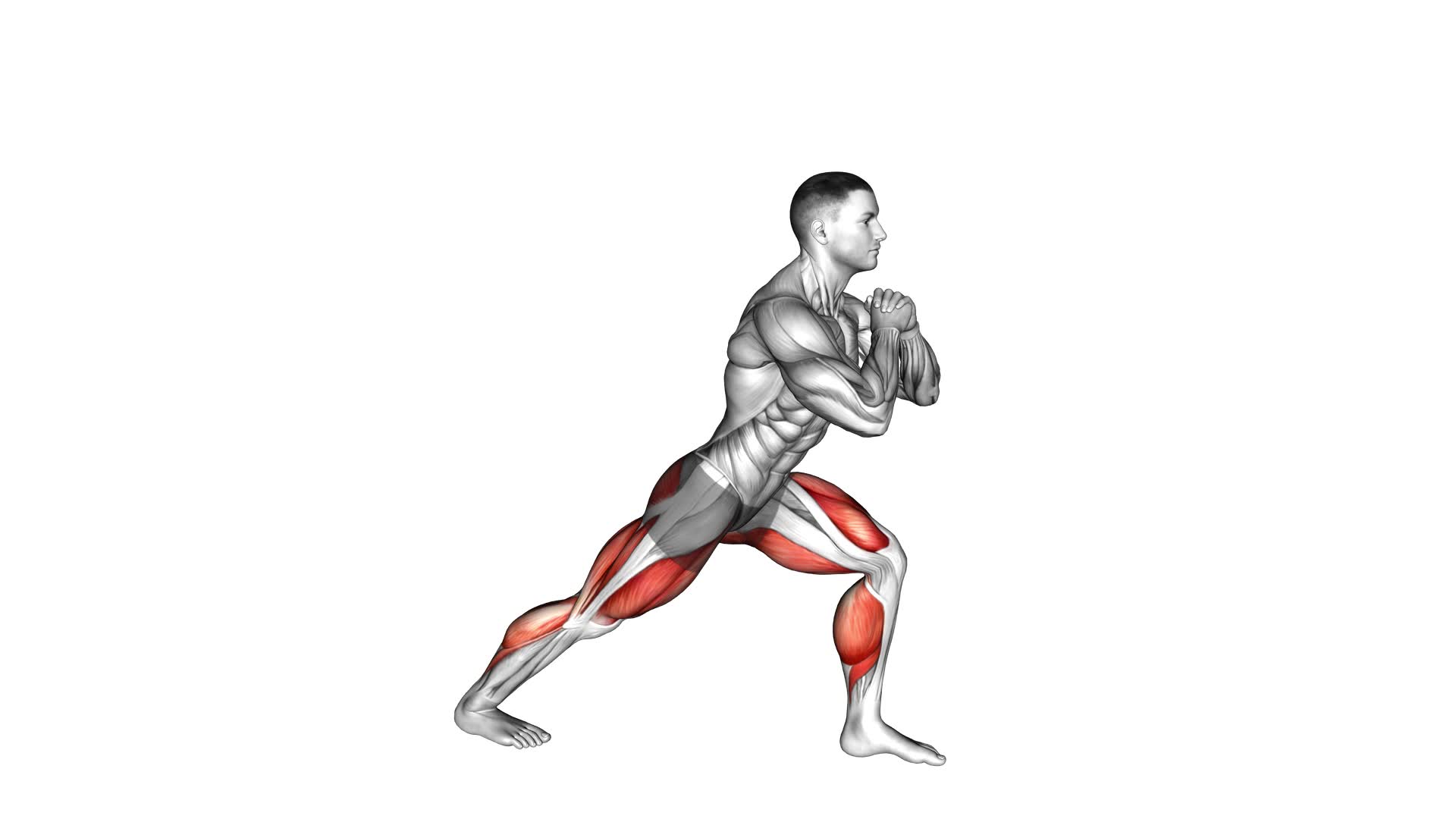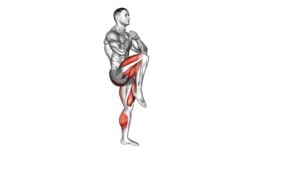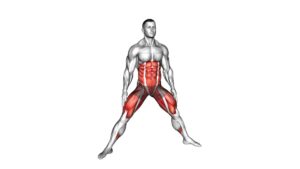Lunge Stretch (male) – Video Exercise Guide & Tips

Are you looking to improve your flexibility and strengthen your lower body? If so, the lunge stretch is a great exercise for you.
Watch This Exercise Video
In this video exercise guide, we will show you the proper form, variations, and common mistakes to avoid.
You'll also find tips on how to get the most out of your lunge stretch and how to incorporate it into your workout routine.
So, grab your mat and let's get started!
Key Takeaways
- The lunge stretch is a highly effective exercise for improving flexibility and range of motion in the lower body.
- It targets muscles in the hips, quadriceps, hamstrings, and calves.
- The lunge stretch can be modified to suit individual needs and fitness level.
- Proper form, such as maintaining good posture and aligning the front knee with the ankle, is crucial to avoid common mistakes and prevent injury.
Benefits of the Lunge Stretch
What are the benefits of the lunge stretch for you?
The lunge stretch is a highly effective exercise that offers numerous benefits, particularly when it comes to flexibility. By incorporating the lunge stretch into your workout routine, you can significantly improve your flexibility and range of motion in your lower body. This stretch primarily targets the muscles in your hips, quadriceps, hamstrings, and calves.
One of the great things about the lunge stretch is that it can be modified to suit your individual needs and fitness level. If you're a beginner, you can start with a basic lunge stretch by stepping one leg forward and bending the knee while keeping the back leg straight. As you become more advanced, you can incorporate variations such as the walking lunge stretch or the reverse lunge stretch. These modifications allow you to challenge yourself and continue progressing in your flexibility goals.
In addition to improving flexibility, the lunge stretch also helps to strengthen your leg muscles and improve your balance. This can be especially beneficial for athletes or individuals involved in activities that require agility and stability. By regularly incorporating the lunge stretch into your routine, you can enhance your overall athletic performance and reduce the risk of injuries.
Proper Form for the Lunge Stretch
To properly execute the lunge stretch, position yourself with one leg forward and the other leg straight behind you. Keep your feet hip-width apart and engage your core for stability.
Now, let's dive into the proper form for the lunge stretch:
- Keep your upper body upright: Maintain good posture throughout the stretch by keeping your chest lifted and shoulders relaxed. Avoid leaning forward or rounding your back.
- Bend your front knee: As you lower your body into the lunge position, ensure that your front knee is directly above your ankle. This helps to protect your knee joint and engage the muscles properly.
- Avoid excessive forward movement of the front knee: Be mindful not to let your front knee go past your toes when lowering into the lunge. This can put unnecessary strain on the knee joint.
It's important to note that the lunge stretch can be modified to suit your individual needs and fitness level. If you find it challenging to maintain balance, you can use a wall or chair for support. Additionally, using equipment such as dumbbells or resistance bands can add intensity to the stretch and target specific muscle groups.
Remember to listen to your body and make any necessary adjustments to ensure proper form and prevent injury.
Variations of the Lunge Stretch
Try incorporating different variations of the lunge stretch to target specific muscle groups and add variety to your workout routine.
Lunges are a great exercise for strengthening and toning the lower body, and they can be modified to increase or decrease the intensity based on your fitness level.
One popular modification is the forward lunge, where you step forward with one foot and lower your body until both knees are bent at a 90-degree angle. This variation primarily targets the quadriceps and glutes.
Another modification is the reverse lunge, where you step backward with one foot and lower your body into a lunge position. This variation puts more focus on the hamstrings and glutes.
Side lunges are also effective for targeting the inner and outer thighs.
To intensify your lunge stretch, you can incorporate weights by holding dumbbells or using a barbell across your shoulders.
By adding these variations to your lunge stretch routine, you can challenge different muscle groups and keep your workouts interesting.
Remember to always maintain proper form and listen to your body to avoid injury.
Common Mistakes to Avoid
3 Common Mistakes to Avoid When Performing the Lunge Stretch
When performing the lunge stretch, it's important to be aware of common mistakes that can hinder your progress and potentially cause injury. By avoiding these mistakes, you can maximize the benefits of this stretching technique. Here are three common mistakes to watch out for:
- Incorrect form: One of the most common mistakes isn't maintaining proper form during the lunge stretch. This includes not keeping your front knee directly over your ankle, allowing your front knee to extend past your toes, or not keeping your back straight. Incorrect form can put unnecessary strain on your joints and limit the effectiveness of the stretch.
- Overstretching: Another mistake to avoid is overstretching. While it's important to challenge yourself, pushing your body too far can lead to muscle strains or tears. Gradually increase the intensity of the stretch and listen to your body's limits.
- Neglecting the opposite side: Many people tend to focus solely on stretching one leg during lunges, neglecting the opposite side. This can create muscle imbalances and increase the risk of injury. Make sure to perform the lunge stretch on both legs equally to maintain balance and symmetry in your body.
Tips for Getting the Most Out of Your Lunge Stretch
To get the most out of your lunge stretch, it's important to focus on proper form techniques. This includes maintaining a straight back, keeping your front knee aligned with your ankle, and engaging your core for stability.
Additionally, aim to hold the stretch for at least 30 seconds on each side to effectively lengthen and release tight muscles.
Proper Form Techniques
Maximize the effectiveness of your lunge stretch with proper form techniques. To ensure you get the most out of your stretch and avoid common mistakes, follow these tips:
- Maintain proper alignment: Keep your front knee directly above your ankle and your back knee hovering just above the ground. This will help prevent strain on your joints and ensure a deeper stretch.
- Engage your core: Activate your abdominal muscles by pulling your belly button towards your spine. This will stabilize your body and enhance the effectiveness of the stretch.
- Focus on your breathing: Take deep breaths in and out as you perform the lunge stretch. This will help relax your muscles and increase flexibility.
By implementing these proper form techniques, you can optimize the benefits of your lunge stretch.
Now let's move on to discussing the recommended duration for stretching.
Stretching Duration Recommendations
For optimal results, aim to hold the lunge stretch for at least 30 seconds. This duration allows your muscles to fully elongate and improve flexibility. Holding the stretch for less than 30 seconds may not provide adequate time for the muscles to relax and lengthen.
However, you can also experiment with longer durations, up to 60 seconds, to further enhance the stretch. It's important to listen to your body and adjust the duration based on your comfort level and flexibility.
Additionally, incorporating different stretching techniques and lunge stretch modifications can help maximize the benefits of your stretch. These modifications include variations like a low lunge, deep lunge, or adding a twist to the stretch. Experiment with these techniques to find what works best for you and your specific needs.
Benefits of Lunge Stretch
To get the most out of your lunge stretch, focus on incorporating variations and modifications that suit your specific needs and comfort level. By doing so, you can maximize the stretching benefits and improve your overall flexibility.
Here are three tips to help you make the most of your lunge stretch:
- Experiment with different lunge variations: Try forward lunges, reverse lunges, and lateral lunges to target different muscle groups and increase the effectiveness of your stretch.
- Use props for support: If you have trouble maintaining balance or need extra support, consider using props such as a chair or wall for stability. This will allow you to focus more on the stretch itself.
- Adjust your stance: Play around with the width and depth of your lunge to find the position that feels most comfortable and provides the best stretch for your body.
Incorporating the Lunge Stretch Into Your Workout Routine
To effectively incorporate the lunge stretch into your workout routine, it's important to understand the benefits of lunges, proper lunge form, and variations for lunges.
Lunges are a versatile exercise that target multiple muscle groups, including the quadriceps, hamstrings, and glutes. By maintaining proper form, which includes keeping your chest up, shoulders back, and knees aligned with your toes, you can maximize the effectiveness of the exercise.
Additionally, incorporating variations such as walking lunges, reverse lunges, or adding weights can help add variety and challenge to your routine.
Benefits of Lunges
Incorporate the lunge stretch into your workout routine to experience the numerous benefits of lunges. Here are some reasons why you should consider adding lunges to your fitness regimen:
- Lunges for weight loss: Lunges are a great exercise for burning calories and shedding pounds. By engaging multiple muscle groups and increasing your heart rate, lunges can help you burn fat and achieve your weight loss goals.
- Lunges for toning muscles: Lunges target several major muscle groups, including your quadriceps, hamstrings, glutes, and calves. By regularly incorporating lunges into your routine, you can strengthen and tone these muscles, giving your legs and buttocks a more sculpted appearance.
- Improved balance and stability: Lunges require you to maintain proper balance and stability, which can help improve your overall coordination and prevent injuries. By regularly practicing lunges, you can enhance your stability and feel more confident in your everyday activities.
Proper Lunge Form
Achieve proper form for the lunge stretch by focusing on maintaining balance and stability while engaging multiple muscle groups.
To start, stand with your feet hip-width apart and take a step forward, bending your front knee to a 90-degree angle. Keep your back straight and your core engaged throughout the movement.
Make sure your front knee is directly above your ankle and your back knee is hovering just above the ground. As you lunge, keep your weight evenly distributed between both feet.
To improve your lunge stretch, you can try different modifications such as adding weights or incorporating a rotation. You can also progress the exercise by increasing the depth of your lunge or adding plyometric movements.
Remember to always listen to your body and adjust the intensity of the stretch accordingly.
Variations for Lunges
To maximize the effectiveness of your lunges and incorporate the lunge stretch into your workout routine, try these variations:
- Walking Lunges: Instead of staying stationary, take a step forward with each lunge, alternating legs. This variation increases the challenge and engages your core and stabilizer muscles.
- Reverse Lunges: Instead of stepping forward, step backward with each lunge. This variation targets your glutes and hamstrings more intensely.
- Jump Lunges: Incorporate plyometric movements into your lunges by jumping and switching legs mid-air. This advanced lunge technique helps improve explosive power and cardiovascular fitness.
By incorporating these lunge variations into your workout routine, you can target different muscle groups, challenge your balance, and improve overall strength and stability.
Remember to start with proper form and gradually increase the difficulty as you progress.
Frequently Asked Questions
How Long Should I Hold the Lunge Stretch for Maximum Benefits?
For maximum benefits, it's important to hold the lunge stretch for an adequate amount of time. The duration will vary depending on your fitness level and flexibility. Generally, holding the stretch for around 30 seconds to 1 minute should be sufficient. However, you can experiment with different durations and lunge stretch variations to find what works best for you.
The benefits of the lunge stretch include improved flexibility, increased range of motion, and reduced muscle tightness.
Can I Do the Lunge Stretch if I Have Knee Problems?
If you have knee problems, you may wonder if you can do the lunge stretch. The lunge stretch can be modified to accommodate knee issues. By making adjustments to the position and depth of the lunge, you can still benefit from this exercise while protecting your knees.
Lunge stretches can be particularly beneficial for athletes with knee problems as they help to improve flexibility, strengthen the lower body, and reduce the risk of further injury.
Is It Necessary to Warm up Before Performing the Lunge Stretch?
Yes, it's necessary to warm up before performing the lunge stretch.
Dynamic warm-up exercises have many benefits, such as increasing blood flow and flexibility, reducing the risk of injury, and improving performance.
Warming up prepares your body for the lunge stretch and helps you achieve proper form.
It's important to maintain proper form during the lunge stretch to avoid strain on your knees and maximize the stretch on your hip flexors and hamstrings.
Can the Lunge Stretch Help Improve My Balance?
The lunge stretch can definitely help improve your balance and stability. By engaging your core and lower body muscles, this exercise challenges your body to maintain control and control while in a single-leg stance. This helps to strengthen the muscles responsible for balance and coordination, leading to improved stability overall.
Additionally, the lunge stretch also stretches and lengthens your muscles, promoting flexibility and preventing injury. Incorporating this exercise into your routine can have great benefits for your balance and stability.
Are There Any Modifications or Alternatives to the Lunge Stretch for Beginners?
For beginners, there are several modifications and alternatives to the lunge stretch. If you're just starting out, you can try a stationary lunge by keeping your back foot planted on the ground.
Another option is to use a chair for support while performing the lunge stretch.
Additionally, you can also try a standing quad stretch or a seated hamstring stretch as alternatives.
These modifications and alternatives can help you ease into the lunge stretch and improve your flexibility gradually.
Conclusion
Incorporating the lunge stretch into your workout routine can provide numerous benefits, including increased flexibility, improved balance, and enhanced lower body strength.
By following proper form and avoiding common mistakes, you can maximize the effectiveness of this exercise. Remember to listen to your body and make adjustments as needed.
Whether you're a beginner or an experienced athlete, the lunge stretch is a valuable addition to any fitness routine.

Author
Years ago, the spark of my life’s passion ignited in my mind the moment I stepped into the local gym for the first time. The inaugural bead of perspiration, the initial endeavor, the very first surge of endorphins, and a sense of pride that washed over me post-workout marked the beginning of my deep-seated interest in strength sports, fitness, and sports nutrition. This very curiosity blossomed rapidly into a profound fascination, propelling me to earn a Master’s degree in Physical Education from the Academy of Physical Education in Krakow, followed by a Sports Manager diploma from the Jagiellonian University. My journey of growth led me to gain more specialized qualifications, such as being a certified personal trainer with a focus on sports dietetics, a lifeguard, and an instructor for wellness and corrective gymnastics. Theoretical knowledge paired seamlessly with practical experience, reinforcing my belief that the transformation of individuals under my guidance was also a reflection of my personal growth. This belief holds true even today. Each day, I strive to push the boundaries and explore new realms. These realms gently elevate me to greater heights. The unique combination of passion for my field and the continuous quest for growth fuels my drive to break new ground.



